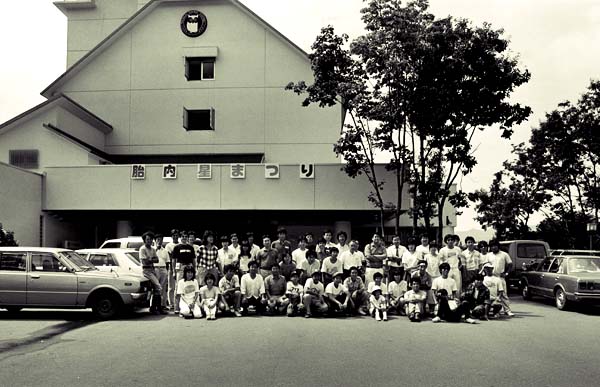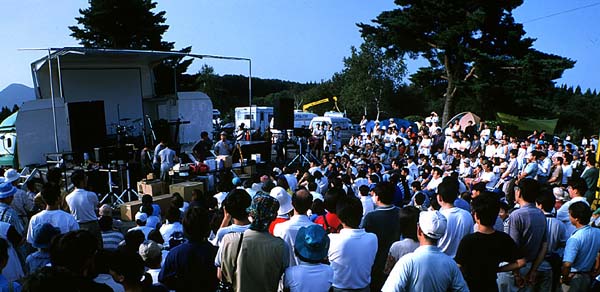TAINAI STAR PARTY

The History of Tainai Star Party
Sky and Telescope 2002 July issue
TAINAI STAR PARTY

Article teaser: Japan's amateur community loves to get together
every midsummer and have fun under the stars. What better place to do it than at
Tainai?
At first, I couldn't imagine that the Tainai Star Party grew bigger event than the Fujii's star party. It seemed to me that Tainai Hill was huge enough for my star party.
Anything large, I knew, could not be run on my own, so I
took my plan to the editorial staff of Tenmon Guido, Japan's leading astronomy magazine.
Its editor Yukihiro Takatsuki loved my idea, and they promised to support
it. For example, to find out what people wanted in a star party, they helped me conduct
a survey of the amateur community. They also assisted in publicizing the event. In
May 1984 we traveled to Kurokawa Village and met with Eizaburo Ajiro, chief
of the village's commerce and tourism department, which manages Tainai Hill. I wanted
the star party to be an annual event, so I proposed that Kurokawa be one of its sponsors.
(Experience has taught me that events like these, organized by outside individuals
or clubs, become a problem when the host town or city doesn't benefit or profit from
the event but the individuals or clubs do.) I'm grateful for the village's decision
to accept our invitation.
At first village officials didn't know how to assist us; they had no idea what a
star party was. But the solution was simple: the staff of Tenmon Guide? and I would
plan and run the event, as long as we could advertise that the star party was being
hosted by Kurokawa Village. They accepted my proposal.
We all agreed that the first Tainai Star Party would be a tamed-down version of my
original grandiose idea. We were, so to speak, testing the waters. We decided to
hold the event at the end of August that year and limit it to one night. Tenmon Guido
then advertised the star party and got telescope manufacturers and dealers involved.
It was truly a homegrown star party, one with very humble expectations. Indeed, only
some 200 people showed up for the first event. But the participants clearly had fun.
As master of ceremonies we hired comedian Koen Yanagiya(a stage name),well
known for his rakugo (traditional Japanese sit-down comedy or comic story telling).
His hilarious "bash auction" of telescopes and goods donated by vendors
was extremely popular (it remains so to this day). All in all, the initial Tainai
Star Party was a success, with amateurs enjoying observing with and testing the newest
commercial telescope models on display.

1984 first Tainai Star Party
For the next star party, in 1985, Tenmon Guido gave the event greater publicity.
The magazine's staff also suggested that it should have more live entertainment.
Clearly, people were coming in to have fun -- that's when we came up with the idea
of adding a rock concert. We also extended the star party's duration to three days
and two nights (it remains this way today). These changes seemed to work -- in 1985
our attendance figure increased to 1,000; the following year it doubled in size.
The appearance of Halley's Comet around this time certainly helped boost the public's
interest in the night sky.
After the comet craze I decided to shift the focus of the star party from an event
solely for serious amateur astronomers to one that kids, adults, families, and the
general public - who didn't necessarily know much about astronomy - could enjoy.
I believed such a family-oriented gathering would be the best way to recruit young
people into astronomy. As a result of this shift, the Tainai Star Party flourished
- becoming even larger each succeeding year.
After five years the star party had become the biggest public event in Kurokawa Village.
Today our attendance figure over the three-day period has reached a record total
of 20,000. That's when the village really gave us its all-out support for our cause.
Together we found ways to share the responsibilities - as the star party's official
host, Kurokawa began to shoulder the cost of electricity, the use of exhibit halls,
and putting up displays. Tenmon Guido continues to handle publicity and technical
support. And my company, the Japan Planetarium Laboratory (JPL), became responsible
for the event planning and administration. This strong collaboration has made it
possible for me to visualize Tainai Star Parties well into the future. Next year
we'll celebrate our 20th anniversary.

Auction at Tainai
Current Issues
One of the pressing issues confronting us today is how to finance the cost of this
ever-growing "mega event." Since the star party's inception, we've relied
heavily on volunteers for help. Right now, we depend on the services of about 20
volunteers. In return, the star party covers their board and lodging from the profits
we make at the auction as well as from donations and the sale of star-party posters
and T-shirts (which I designed). But due to the current economic recession in Japan,
our budget for supporting the volunteers has decreased. For the same reason, we cannot
depend on Kurokawa Village's star-party budget to remain the same. For now, it appears
that the solution is to collect booth fees from exhibitors; currently we don't charge
vendors for displaying their goods. I expect everyone will cooperate and do whatever
it takes to keep the Tainai Star Party alive, because this is the wish expressed
by the attendees.
Another issue is that, after nearly 20 years of dedication and hard work, our volunteers
are getting old. In the beginning, when I was only 25, I could walk around the field
in bare feet to direct the programs. Today, even though the programs proceed without
my direction, I get blisters on my feet without even walking. Soon, I believe, we'll
have to figure out how to pass the star-party torch to a younger generation of volunteers.
Then there is the issue of time. As the event grows, it requires more and more time
to plan, coordinate, and carry out. My colleague at JPL, Nanayo Wakiya, and I must
sacrifice a week of work just to process all the registrations. Each year, I also
regret that I cannot spend as much time as I would like with star-party guests, especially
those who have traveled from overseas, because I'm so busy. But I'm always happy
to learn that most participants enjoy themselves and leave with a smile, saying:
"It was so much fun. We'll be back." Such comments give me the energy to
carry on.
Above all, my biggest boost comes from my young children -- and those of others --
who look forward to the star party each year. I cherish their smiles the most because
they tell me we're doing something right: we're reaching the younger generations
and are teaching them about the beauty of the heavens.
Potentially some of the elements of the Tainai Star Party will continue to evolve
in the coming years. But the event's original goal -- to unite sky lovers from all
over the world under the beautiful starlit sky of Tainai -- will remain unchanged.
This year's star party is slated for August 23-25. There is no registration deadline
or fee. Just come and enjoy yourself. For more information contact me at numazawa@jplnet.com
or go to my Web site at www.jplnet.com/tainai/.
Fig. #1: Daytime photo of people and telescopes at Tainai
<caption>Each August thousands of Japanese amateur astronomers and their families
leave their crowded urban centers and converge on a hilltop park in Niigata Prefecture,
250 kilometers (150 miles) north of Tokyo, for three days of a carnival-like astronomy
get-together -- the Tainai Star Party. This free annual event, now in its 19th year,
features guest speakers, commercial exhibits and demonstrations, nighttime live entertainment,
kids' activities, swap tables, raffles, auctions, and lots more. Unless otherwise
noted, all photographs in this article are by the author.
Fig. #2: Nighttime photo of people and a big telescope at Tainai
<caption>At Tainai amateurs get a chance to try out the latest commercial telescope
models, though, owing to the bright surroundings, the test objects are largely limited
to the Moon, planets, and brightest deep-sky targets. More than two dozen manufacturers
and dealers participated in last year's star party, including AstroArts, Epson, Fujicolor,
Kowa, Tele Vue, Takahashi, Vixen, Pentax, Showa, Mutoh, Miyauchi, and Fujinon.
Fig. #3: Night stalls selling various merchandise
<caption>The hunt for bargains lasts until well past midnight. Rows of brightly
lit booths and tents show their wares, from premium apochromatic refractors, cameras,
eyepieces, and telescope accessories, to space art, astronomical T-shirts, jewelry,
and trinkets. Other stalls vying for the attendees' attention sell hot meals and
cold beverages, including beer and sake (Japanese rice wine).
Fig. #4: Steve O'Meara with giant binoculars
<caption>Following the tradition of the Stellafane telescope-makers' convention,
Tainai also showcases homegrown ingenuity, such as this motorized observing chair
for scanning the skies with giant binoculars. Here S&T contributing editor Stephen
James O'Meara takes the chair for a test drive while editor in chief Richard Tresch
Fienberg (far right) looks on.
Fig. #5: Photo of rock concert
<caption>Unlike its American counterparts, where white lights, flash photography,
and loud music are strictly banned, the Tainai Star Party features Saturday-night
folk and rock concerts, complete with strobe lights and fireworks. Performers include
editors of Tenmon Guido, the country's largest monthly astronomy publication. People
who want to do some "serious" observing set up their scopes or camp out
in outlying dark areas away from the main exhibit grounds.
Fig. #6A and #6B: Photos of kids with stuffed toys and with a giant bettle, respectively.
<caption>Left: Activities to keep youngsters preoccupied include raffles of
toys (above) as well as computer games, astronomy quizzes, and hands-on demonstrations
on biology and weather forecasting. Right: Kids also play with Japanese stag beetles,
tying them on a string and twirling the beetles to make them fly. Photographs by
P.K. Chen and Richard Tresch Fienberg, respectively.
Fig. #7: Launching a model rocket
<caption>Popular daytime activities include boomerang-throwing demonstrations
and model-rocket launchings. In 1996 Tainai also held a 20-km bicycle race.
END
Shigemi Numazawa wishes to thank Akira Banch and Yoko Suzuki who translated Japanese to English.